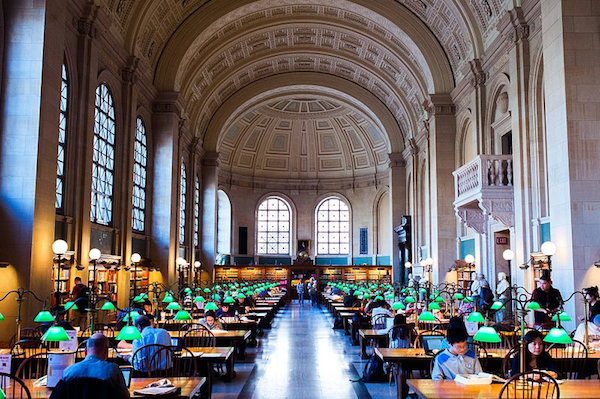
Photo by: Brian Johnson
The reading room at the main Boston Public Library.
Libraries have always done more than lend books, and they do much more than that now. As Suzanne Travers has reported in the first two installations of her City Limits series about branch libraries, these sites now serve as classrooms, after-school centers and job-search facilities as much as reading rooms.
But while libraries have taken on a lot of jobs in recent years, their traditional purpose—a place where people can read and borrow the written word—is certainly not a task anyone else is going to take on.
So, the availability of physical books is still important. But as Travers reported yesterday:
… for all three systems, money for new materials has been in steady and steep decline. As overall budgets for the libraries shrunk by 16 percent from fiscal year 2009 to fiscal year 2013, funds for books and digital materials were cut by more than half. QPL’s materials budget was down 58 percent, from $9.65 million in ’09 to $4.06 million in ’13. For the current fiscal year, Brooklyn’s materials budget dropped another $500,000 (or 7 percent ) from the previous year, to $6.2 million. NYPL projects it will spend about $15 million for materials this year.
The Queens system’s spending on materials equals about 4.9 percent of its budget. Brooklyn’s outlay is about 7.6. percent of its total spending, and NYPL (which serves Manhattan, the Bronx and Staten Island) puts about 13.5 percent of its spending into materials.
How does that compare with the other libraries among the top 10 local systems ranked by total collection (New York is No. 2 and Queens No. 6 on that list, according to the American Library Association)?
We were unable to find figures for Los Angeles’ city libraries (the county has a separate system) but here are the rest.
Boston 10.9 percent
Cincinnati 15.6 percent
Detroit 4.5 percent
LA County 7 percent
Chicago 8 percent
San Diego 5.9 percent
Philadelphia 11.3 percent
This post is part of an ongoing project looking at the potential for New York’s libraries to fill a critical gap in our civic infrastructure, as well as the challenges and difficult choices the library systems face. It is supported by the Charles H. Revson Foundation. Read the full project here.








